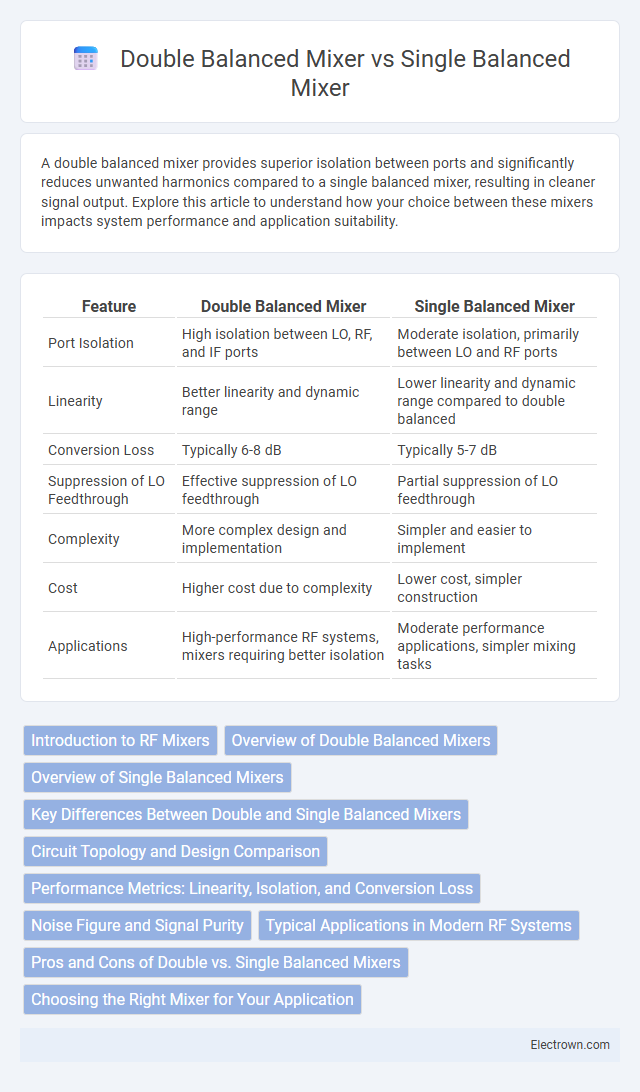A double balanced mixer provides superior isolation between ports and significantly reduces unwanted harmonics compared to a single balanced mixer, resulting in cleaner signal output. Explore this article to understand how your choice between these mixers impacts system performance and application suitability.
Table of Comparison
| Feature | Double Balanced Mixer | Single Balanced Mixer |
|---|---|---|
| Port Isolation | High isolation between LO, RF, and IF ports | Moderate isolation, primarily between LO and RF ports |
| Linearity | Better linearity and dynamic range | Lower linearity and dynamic range compared to double balanced |
| Conversion Loss | Typically 6-8 dB | Typically 5-7 dB |
| Suppression of LO Feedthrough | Effective suppression of LO feedthrough | Partial suppression of LO feedthrough |
| Complexity | More complex design and implementation | Simpler and easier to implement |
| Cost | Higher cost due to complexity | Lower cost, simpler construction |
| Applications | High-performance RF systems, mixers requiring better isolation | Moderate performance applications, simpler mixing tasks |
Introduction to RF Mixers
RF mixers are essential components in wireless communication systems, converting signals between different frequencies through nonlinear mixing processes. Double balanced mixers offer superior performance by suppressing both input signals' unwanted feedthrough and spurious responses, resulting in higher isolation and better linearity compared to single balanced mixers. Single balanced mixers provide moderate isolation and simpler design but are more susceptible to feedthrough and noise, making double balanced mixers preferred in high-performance RF applications.
Overview of Double Balanced Mixers
Double Balanced Mixers offer superior isolation between the local oscillator, RF, and IF ports compared to Single Balanced Mixers, minimizing signal leakage and spurious responses. They use two balanced mixer elements and a quadrature hybrid or transformer to cancel out undesired mixing products, enhancing dynamic range and linearity. Your RF system benefits from reduced intermodulation distortion and improved noise performance when employing Double Balanced Mixers.
Overview of Single Balanced Mixers
Single balanced mixers utilize one balanced component, typically a balanced diode ring or transistor pair, to suppress either the local oscillator (LO) or radio frequency (RF) feedthrough, enhancing signal clarity. Compared to double balanced mixers, they offer simpler design and lower noise figure but provide less isolation and conversion gain. Your choice between single and double balanced mixers depends on the application's requirements for signal purity and complexity.
Key Differences Between Double and Single Balanced Mixers
Double balanced mixers provide superior isolation between port signals, effectively minimizing LO (local oscillator) and RF signal leakage, while single balanced mixers allow more leakage due to having only one balanced port. The double balanced design uses two baluns to simultaneously balance both the LO and RF ports, enhancing suppression of unwanted mixing products and improving linearity compared to the single balanced mixer, which balances only one input. Consequently, double balanced mixers are preferred in high-performance applications requiring low spurious signals, whereas single balanced mixers are simpler and cost-effective for less critical frequency translation tasks.
Circuit Topology and Design Comparison
Double balanced mixers utilize a configuration of four diodes arranged in a ring or a pair of balanced transformers, providing superior isolation between the radio frequency (RF), local oscillator (LO), and intermediate frequency (IF) ports compared to single balanced mixers. Single balanced mixers typically employ two diodes or a single balanced transformer, offering moderate suppression of LO or RF signals but less overall isolation and increased spurious signal generation. The more complex circuit topology of double balanced mixers results in improved linearity and reduced noise figure, making them preferable in high-performance communication systems.
Performance Metrics: Linearity, Isolation, and Conversion Loss
Double balanced mixers typically offer superior linearity and isolation compared to single balanced mixers, making them ideal for applications requiring minimal signal distortion and crosstalk. They provide higher port-to-port isolation, reducing local oscillator leakage into input ports, which enhances overall system performance. Your choice depends on the importance of conversion loss; double balanced mixers generally exhibit slightly higher conversion loss but compensate with better linearity and isolation performance.
Noise Figure and Signal Purity
Double balanced mixers exhibit superior noise figure performance compared to single balanced mixers due to enhanced isolation between ports, reducing unwanted signal leakage and intermodulation distortion. This improved isolation results in higher signal purity, minimizing harmonic generation and spurious responses in RF applications. Single balanced mixers typically have higher noise figures and lower signal purity because of less effective suppression of local oscillator feedthrough and RF-IF port crosstalk.
Typical Applications in Modern RF Systems
Double balanced mixers excel in modern RF systems requiring high isolation and suppression of unwanted signals, such as in radar, communications, and signal processing applications, where minimizing spurious outputs is critical. Single balanced mixers are commonly used in simpler RF designs like frequency conversion in receivers and transmitters, offering moderate isolation at a lower cost and complexity. Your choice depends on system requirements for linearity, noise performance, and signal isolation.
Pros and Cons of Double vs. Single Balanced Mixers
Double balanced mixers offer superior isolation between ports, reducing signal leakage and spurious responses compared to single balanced mixers, making them ideal for high-performance RF applications. However, double balanced mixers tend to be more complex, larger, and costlier due to additional diodes and transformer windings. Single balanced mixers provide simpler design and lower cost but suffer from poorer port isolation and higher even-order distortion, which can impact signal quality in sensitive environments.
Choosing the Right Mixer for Your Application
Double balanced mixers offer superior isolation between ports and lower spurious signals, making them ideal for high-performance RF applications requiring minimal interference and distortion. Single balanced mixers provide a simpler design with fewer components and moderate isolation, suitable for cost-sensitive projects where some signal leakage is acceptable. Selecting the right mixer depends on factors like required linearity, isolation, conversion loss, and the overall system complexity.
Double Balanced Mixer vs Single Balanced Mixer Infographic

 electrown.com
electrown.com